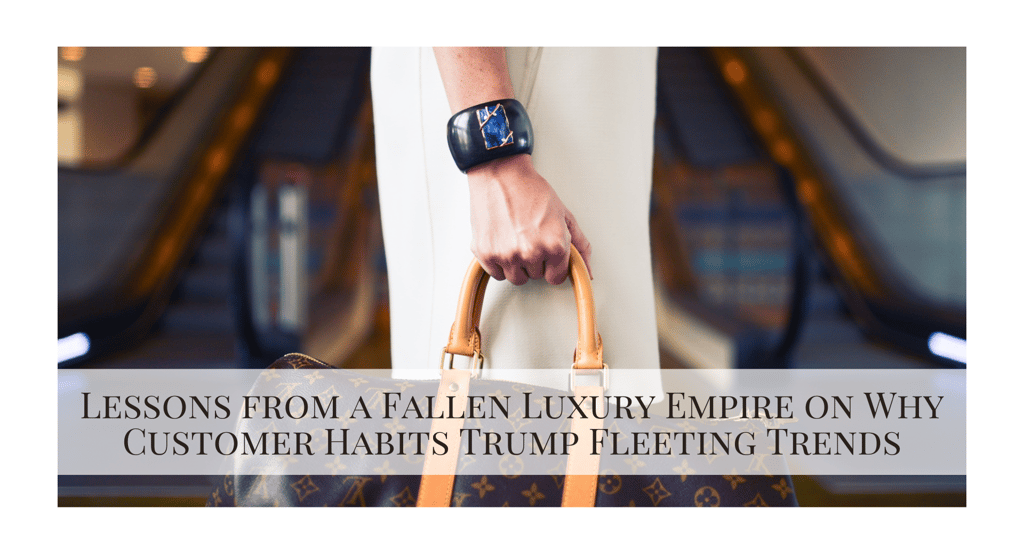When "Vision" Blinds: Lessons from a Fallen Luxury Empire on Why Customer Habits Trump Fleeting Trends
5/8/20243 min read


In today's fast-paced market, the siren song of "disruptive innovation" and "brand refreshes" can be incredibly tempting. We're often told to be bold, to break molds, to lead customers to new horizons. But what if that leadership ignores the very bedrock of its success: deeply ingrained customer habits?
A cautionary tale I recently came across, aptly titled "How Ignoring Customer Habits Killed a Luxury Empire," paints a vivid picture of this exact scenario – and the lessons are critical for product managers, marketers, and business leaders everywhere, whether you're in luxury goods, SaaS, or anything in between.
The Ascent: Built on Empathy
Imagine a global luxury powerhouse. For over 25 years, it didn't just lead its niche; it defined it. Its secret? Not revolutionary tech or flashy campaigns, but a profound, almost granular understanding of its clientele. A senior executive was on the sales floor daily, listening, learning, and understanding why customers bought.
They discovered a crucial pattern: customers had developed an almost ritualistic habit of returning for two signature designs, consistently, in every new color palette. These weren't just transactions; they were affirmations of a trusted relationship. This deep empathy fueled product decisions, leading to an astronomical Customer Lifetime Value (LTV) and consistent double-digit growth. They were serving, and therefore strengthening, valuable customer habits.
The Pivot: When "Vision" Becomes a Liability
Then came the change at the top. A new design leader arrived, armed with "bold visions" to "modernize" the brand. Concerns about alienating loyal customers were dismissed with a now-infamous line delivered at an all-hands meeting:
"Forget what has gone before. Forget what customers bought in the past. From now on, customers will buy what we TELL them to buy."
This philosophy, astoundingly, drove the new strategy. Even more incredibly, this leader reportedly never set foot in a store while customers were present, never interacted with a single one. Decisions were made in an echo chamber, far removed from the loyalists who had built the brand.
The Inevitable Fall: Loyalty Evaporates
The results were as predictable as they were tragic. Loyal customers, some of whom had spent tens of thousands annually and built entire home aesthetics around specific designs, found their habits shattered. Their trusted products were gone, replaced by a "refreshed" line they didn't ask for and didn't want.
One particularly poignant anecdote tells of a client who had spent $86,000 over three years, incredulously asking, "You mean you no longer stock that...? But I’ve built my entire beach home around that design." She was never seen again.
Store traffic dried up. Within a couple of years, stores began closing. The multi-hundred-million-dollar empire was eventually sold for pennies on the dollar. A stark testament to what happens when a brand values its own "vision" over the established habits of its customers.
Modern Parallels: Jaguar's Gamble
This isn't an isolated tale of luxury woe. The article draws parallels to Jaguar's recent rebrand, which saw a dramatic departure from its century-old heritage – sweeping curves and the iconic leaping cat exchanged for boxy, abstract designs. While aiming for a new audience, they risk alienating a loyal base whose habits revolved around that distinct Jaguar identity. It's like Slack suddenly removing channels to "reduce clutter"—technically innovative, perhaps, but devastating to core user workflows.
Red Flags for Your Own Organization
The highlights of the warning signs we should all be vigilant for:
Design decisions representing a total departure from the company’s traditional brand identity.
Major user-facing changes driven by individuals far removed from day-to-day customer contact.
Leadership that rarely, if ever, interacts with actual customers.
Prioritizing design awards and press over customer retention metrics.
A focus on "disruptive innovation" without understanding the existing habits and workflows that could be catastrophically disrupted.
The Product Manager's Mandate: Protect Customer Habits
So, what's the antidote? How do we innovate without alienating? A skilled product leader, as the article suggests, would always:
Understand the Fundamentals: How does your company really make money? Who are your core customers?
Connect Deeply: Are you close enough to identify which elements are essential to customer habits versus merely decorative?
Define Success Clearly: Are metrics focused on adoption and retention, not just "refreshment"?
Pilot and Preview: Test changes with limited user sets before a full rollout. Gauge reactions, measure impact.
Transition Gradually: Give users clear milestones and ample time to adapt if features are being retired or significantly changed.
The Enduring Truth: Customers Follow Habits
Whether it's luxury goods or software, the foundation of sustainable success often lies in the habits customers form around your product. These habits are built carefully over years and are immensely valuable. They represent trust, reliability, and a product becoming an integral part of a user's life or workflow.
The deadliest words any leader can unleash aren't about daring innovation, but about "refreshing" a brand or product without a profound respect for those hard-won habits.
Innovate, yes. Evolve, absolutely. But do so with empathy, with a deep understanding of the user, and with a strategy that honors the established patterns that made you successful in the first place.
